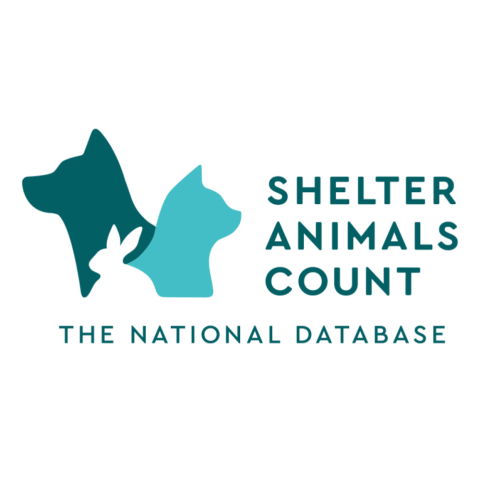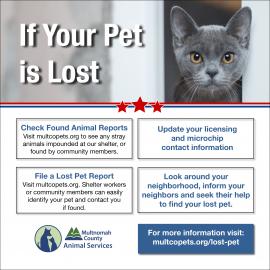Recent National Animal Shelter Data Shows Significant Increase in Stray Dog Intake
Recent National Animal Shelter Data Shows Significant Increase in Stray Dog Intake
Shelter Animals Count (SAC) and Multnomah County Animal Services (MCAS) Offer Tips to Keep Pets Home Safe.
July is National Lost Pet Prevention Month - spread the word to prevent lost pets!
Troutdale, OR, 7/7/2023 – Shelter Animals Count (SAC), the most trusted and current source for animal sheltering data, encourages pet owners to take precautions to keep their pets home and safe, in recognition of National Lost Pet Prevention Month, observed every July.
According to SAC’s Industry Trends Dashboard, national data from January-May 2023 has shown a 4% increase in stray intake compared to 2022, and an increase of nearly 18% compared to 2021. This trend has been especially dramatic for dogs. Data for Oregon is consistent with national trends, and MCAS has also seen increases in found animal intakes.
Over the past two years, the national stray intake rate for dogs has increased significantly. Data from January-May 2023 shows a 10% increase in stray dog intake compared to 2022, and an increase of 30% compared to 2021.
For each of the past three years, only about 10% of animals entering shelters nationally are returned to their owners. At MCAS in May 2023, 47% of adult dogs and 14.5% of adult cats were returned to owners. Pets with identification - a microchip with current contact information, or a current license - are reunited with their owners in greater numbers than pets without identification.
Helping keep pets – especially dogs – out of animal shelters is especially vital right now, as shelters across the country continue to struggle. According to SAC’s Outcome Data Analysis report for Q1 2023, Dog intake increased 7% during the first quarter of 2023 compared to the same period last year. Additionally, 3.3% more canines entered than left shelters during the same time, contributing to the ongoing over-capacity crisis for dogs.
Download the full report from SAC (PDF)
“Summer is the busiest time of year for shelters, with increases in kittens and puppies, as well as lost pets who commonly escape their homes or yards during fireworks and other summer festivities,” said Stephanie Filer, Executive Director of Shelter Animals Count. “Shelters are now in their third year of having too many animals and not enough adoptions, especially for dogs, and many shelters are having to make difficult decisions about how to manage limited space. This makes it more important than ever to keep our canine companions home and safe, and out of overburdened shelters.”
Lost Pet Guidelines
No matter how careful we are, pets can still get loose, so it’s best to be prepared. Here are tips to help keep pets home and out of shelters:
- Make sure your pet is microchipped and wearing a collar with identifying information, including a phone number. This helps them to be quickly and easily reunited with you should they become lost. Make sure tags are current and microchip information is updated with the veterinarian or shelter that implanted the chip. Microchips from MCAS can be updated at my24pet.com.
- Ensure you have current photos of your pet from all angles. These can be used to make flyers and post on neighborhood apps and lost pet pages if the pet gets lost.
- If your pet gets lost, start looking in your neighborhood right away. Carry a leash or carrier with you, and make sure to have your cell phone in case someone calls you while you’re out looking.
- Call the shelter at 503-988-7387 and visit the website at multcopets.org/lost-pet to learn how to file a lost pet report, and other steps you can take to find them.
- Check local social media pages and neighborhood apps and post a photo of your lost pet. These resources are extremely helpful for posting lost and found pets in real-time. Many happy reunions have occurred quickly because of the power of social media.
- Visit the shelter the first day if possible, and at least every other day to look for your pet in person. People’s perception of breed and description can vary, so relying on someone who doesn’t know your pet to find it in the shelter may not be effective.
- Create posters with a clear photo of your pet, with a brief description and a cell number. Place the flyers around your neighborhood and at any local businesses.
- Don’t give up! Lost pets have been found weeks, months or even years after they’ve been lost.
- If you find a lost pet, try to find their owners by walking the neighborhood and checking neighborhood apps/social media groups before taking them to a shelter. Many pets are reunited with their owners within minutes or hours without ever leaving the neighborhood.
Learn more about finding lost pets
About Shelter Animals Count (SAC)
SAC is a collaborative, industry-led nonprofit organization formed by a diverse group of animal welfare agencies to create and share The National Database of sheltered animal statistics, providing facts and enabling insights that will improve animal welfare throughout the country.
About Multnomah County Animal Services (MCAS)
The North Star of Multnomah County Animal Services is to provide excellence in the quality of care for animals in its shelter, and to provide equitable service to the community.
MCAS is the primary agency serving found animals from all of the jurisdictions within Multnomah County, including: the cities of Portland, Gresham, Troutdale, Fairview, Wood Village, and all unincorporated areas. MCAS is responsible for enforcing Oregon animal laws pertaining to cruelty, neglect, and minimum care standards, and for enforcing Multnomah County Code Chapter 13. MCAS is a Division of the Multnomah County Department of Community Services.

Heartsspeak, per SAC

Shelter Animals Count (SAC)

